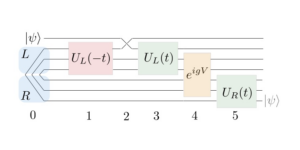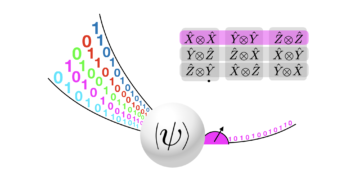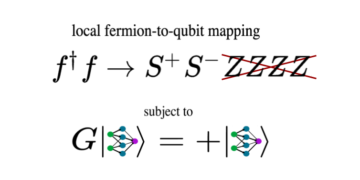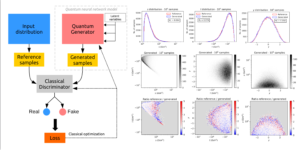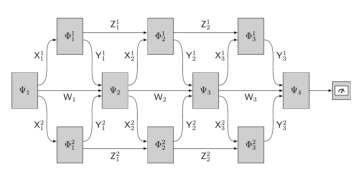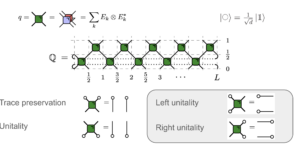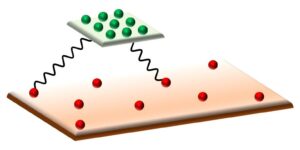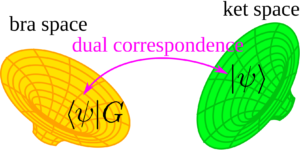1Leibniz University Hannover, Hannover, Germany
2Stewart Blusson Quantum Matter Institute, University of British Columbia, Vancouver, Canada
3School of Physics, Nankai University, Tianjin, China
4Department of Physics and Astronomy, University of British Columbia, Vancouver, Canada
Find this paper interesting or want to discuss? Scite or leave a comment on SciRate.
Abstract
We present a new framework for assessing the power of measurement-based quantum computation (MBQC) on short-range entangled symmetric resource states, in spatial dimension one. It requires fewer assumptions than previously known. The formalism can handle finitely extended systems (as opposed to the thermodynamic limit), and does not require translation-invariance. Further, we strengthen the connection between MBQC computational power and string order. Namely, we establish that whenever a suitable set of string order parameters is non-zero, a corresponding set of unitary gates can be realized with fidelity arbitrarily close to unity.

Featured image: Representations of the symmetry group involved in the description of MBQC on symmetric states: linear representations (blue) and projective representations (red and green). For more information, see the caption of Fig. 6.
Popular summary
► BibTeX data
► References
[1] R. Raussendorf and H.-J. Briegel, A one-way quantum computer, Phys. Rev. Lett. 86, 5188 (2001). doi: 10.1103/PhysRevLett.86.5188.
https://doi.org/10.1103/PhysRevLett.86.5188
[2] D. Gross, S. T. Flammia, and J. Eisert, Most Quantum States Are Too Entangled To Be Useful As Computational Resources, Phys. Rev. Lett. 102, 190501 (2009). doi: 10.1103/PhysRevLett.102.190501.
https://doi.org/10.1103/PhysRevLett.102.190501
[3] A. C. Doherty and S. D. Bartlett, Identifying Phases of Quantum Many-Body Systems That Are Universal for Quantum Computation, Phys. Rev. Lett. 103, 020506 (2009). doi: 10.1103/PhysRevLett.103.020506.
https://doi.org/10.1103/PhysRevLett.103.020506
[4] T. Chung, S. D. Bartlett and A. C. Doherty, Characterizing measurement-based quantum gates in quantum many-body systems using correlation functions, Can. J. Phys. 87, 219 (2009). doi: 10.1139/P08-112.
https://doi.org/10.1139/P08-112
[5] A. Miyake, Quantum computation on the edge of a symmetry-protected topological order, Phys. Rev. Lett. 105, 040501 (2010). doi: 10.1103/PhysRevLett.105.040501.
https://doi.org/10.1103/PhysRevLett.105.040501
[6] A.S. Darmawan, G.K. Brennen, S.D. Bartlett, Measurement-based quantum computation in a two-dimensional phase of matter, New J. Phys. 14, 013023 (2012). doi: 10.1088/1367-2630/14/1/013023.
https://doi.org/10.1088/1367-2630/14/1/013023
[7] D.V. Else, I. Schwarz, S.D. Bartlett and A.C. Doherty, Symmetry-protected phases for measurement-based quantum computation, Phys. Rev. Lett. 108, 240505 (2012). doi: 10.1103/PhysRevLett.108.240505.
https://doi.org/10.1103/PhysRevLett.108.240505
[8] D.V. Else, S.D. Bartlett, and A.C. Doherty, Symmetry protection of measurement-based quantum computation in ground states, New J. Phys. 14, 113016 (2012). doi: 10.1088/1367-2630/14/11/113016.
https://doi.org/10.1088/1367-2630/14/11/113016
[9] Z.C. Gu and X.G. Wen, Tensor-entanglement-filtering renormalization approach and symmetry-protected topological order, Phys. Rev. B 80, 155131 (2009). doi: 10.1103/PhysRevB.80.155131.
https://doi.org/10.1103/PhysRevB.80.155131
[10] X. Chen, Z.C. Gu, and X.G. Wen, Local unitary transformation, long-range quantum entanglement, wave function renormalization, and topological order, Phys. Rev. B 82, 155138 (2010). doi: 10.1103/PhysRevB.82.155138.
https://doi.org/10.1103/PhysRevB.82.155138
[11] Norbert Schuch, David Perez-Garcia, and Ignacio Cirac, Classifying quantum phases using matrix product states and projected entangled pair states, Phys. Rev. B 84, 165139 (2011). doi: 10.1103/PhysRevB.84.165139.
https://doi.org/10.1103/PhysRevB.84.165139
[12] Yoshiko Ogata, Classification of symmetry protected topological phases in quantum spin chains, arXiv:2110.04671. doi: 10.48550/arXiv.2110.04671.
https://doi.org/10.48550/arXiv.2110.04671
arXiv:2110.04671
[13] X. Chen, Z.C. Gu, Z.X. Liu, X.G. Wen, Symmetry protected topological orders and the group cohomology of their symmetry group, Phys. Rev. B 87, 155114 (2013). doi: 10.1103/PhysRevB.87.155114.
https://doi.org/10.1103/PhysRevB.87.155114
[14] R. Raussendorf, J. Harrington, K. Goyal, A fault-tolerant one-way quantum computer, Ann. Phys. (N.Y.) 321, 2242 (2006). doi: 10.1016/j.aop.2006.01.012.
https://doi.org/10.1016/j.aop.2006.01.012
[15] J. Miller and A. Miyake, Resource Quality of a Symmetry-Protected Topologically Ordered Phase for Quantum Computation, Phys. Rev. Lett. 114, 120506 (2015). doi: 10.1103/PhysRevLett.114.120506.
https://doi.org/10.1103/PhysRevLett.114.120506
[16] Robert Raussendorf, Dongsheng Wang, Abhishodh Prakash, Tzu-Chieh Wei, David Stephen, Symmetry-protected topological phases with uniform computational power in one dimension, Phys. Rev. A 96, 012302 (2017). doi: 10.1103/PhysRevA.96.012302.
https://doi.org/10.1103/PhysRevA.96.012302
[17] D.T. Stephen, D.-S. Wang, A. Prakash, T.-C. Wei, R. Raussendorf, Computational Power of Symmetry-Protected Topological Phases, Phys. Rev. Lett. 119, 010504 (2017). doi: 10.1103/PhysRevLett.119.010504.
https://doi.org/10.1103/PhysRevLett.119.010504
[18] D.T. Stephen, Computational power of one-dimensional symmetry-protected topological phases, MSc Thesis, University of British Columbia (2017). doi: 10.14288/1.0354465.
https://doi.org/10.14288/1.0354465
[19] R. Raussendorf, C. Okay, D.-S. Wang, D. T. Stephen, and H. P. Nautrup, Computationally universal phase of quantum matter, Phys. Rev. Lett. 122, 090501 (2019). doi: 10.1103/PhysRevLett.122.090501.
https://doi.org/10.1103/PhysRevLett.122.090501
[20] T. Devakul and D.J. Williamson, Universal quantum computation using fractal symmetry-protected cluster phases, Phys. Rev. A 98, 022332 (2018). doi: 10.1103/PhysRevA.98.022332.
https://doi.org/10.1103/PhysRevA.98.022332
[21] David T. Stephen, Hendrik Poulsen Nautrup, Juani Bermejo-Vega, Jens Eisert, Robert Raussendorf, Subsystem symmetries, quantum cellular automata, and computational phases of quantum matter, Quantum 3, 142 (2019). doi: 10.22331/q-2019-05-20-142.
https://doi.org/10.22331/q-2019-05-20-142
[22] Austin K. Daniel, Rafael N. Alexander, Akimasa Miyake, Computational universality of symmetry-protected topologically ordered cluster phases on 2D Archimedean lattices, Quantum 4, 228 (2020). doi: 10.22331/q-2020-02-10-228.
https://doi.org/10.22331/q-2020-02-10-228
[23] A. Miyake, Quantum computational capability of a 2D valence bond solid phase, Ann. Phys. 326, 1656-1671 (2011). doi: 10.1016/j.aop.2011.03.006.
https://doi.org/10.1016/j.aop.2011.03.006
[24] Tzu-Chieh Wei, Ian Affleck, Robert Raussendorf, The Affleck-Kennedy-Lieb-Tasaki State on a Honeycomb Lattice is a Universal Quantum Computational Resource, Phys. Rev. Lett. 106, 070501 (2011). doi: 10.1103/PhysRevLett.106.070501.
https://doi.org/10.1103/PhysRevLett.106.070501
[25] Sam Roberts and Stephen D. Bartlett, Symmetry-Protected Self-Correcting Quantum Memories, Phys. Rev. X 10, 031041 (2020). doi: 10.1103/PhysRevX.10.031041.
https://doi.org/10.1103/PhysRevX.10.031041
[26] D. Gross and J. Eisert, Novel Schemes for Measurement-Based Quantum Computation, Phys. Rev. Lett. 98, 220503 (2007). doi: 10.1103/PhysRevLett.98.220503.
https://doi.org/10.1103/PhysRevLett.98.220503
[27] Gabriel Wong, Robert Raussendorf, Bartlomiej Czech The Gauge Theory of Measurement-Based Quantum Computation, arXiv:2207.10098. doi: 10.48550/arXiv.2207.10098.
https://doi.org/10.48550/arXiv.2207.10098
arXiv:2207.10098
[28] M. den Nijs and K. Rommelse, Preroughening transitions in crystal surfaces and valence-bond phases in quantum spin chains, Phys. Rev. B 40, 4709 (1989). doi: 10.1103/PhysRevB.40.4709.
https://doi.org/10.1103/PhysRevB.40.4709
[29] H. Tasaki, Quantum liquid in antiferromagnetic chains: A stochastic geometric approach to the Haldane gap, Phys. Rev. Lett. 66, 798 (1991). doi: 10.1103/PhysRevLett.66.798.
https://doi.org/10.1103/PhysRevLett.66.798
[30] D. Perez-Garcia, M.M. Wolf, M. Sanz, F. Verstraete, and J.I. Cirac, String Order and Symmetries in Quantum Spin Lattices, Phys. Rev. Lett. 100, 167202 (2008). doi: 10.1103/PhysRevLett.100.167202.
https://doi.org/10.1103/PhysRevLett.100.167202
[31] A. Molnar, J. Garre-Rubio, D. Perez-Garcia, N. Schuch, J.I. Cirac, Normal projected entangled pair states generating the same state, New J. Phys. 20, 113017 (2018). doi: 10.1088/1367-2630/aae9fa.
https://doi.org/10.1088/1367-2630/aae9fa
[32] J.I. Cirac, D. Perez-Garcia, N. Schuch, and F. Verstraete, Matrix product states and projected entangled pair states: Concepts, symmetries, theorems, Rev. Mod. Phys. 93, 045003 (2021). doi: 10.1103/RevModPhys.93.045003.
https://doi.org/10.1103/RevModPhys.93.045003
[33] M.B. Hastings, Lieb-Schultz-Mattis in higher dimensions, Phys. Rev. B 69, 104431 (2004). doi: 10.1103/PhysRevB.69.104431.
https://doi.org/10.1103/PhysRevB.69.104431
[34] Bei Zeng, Xie Chen, Duan-Lu Zhou, Xiao-Gang Wen, Quantum Information Meets Quantum Matter – From Quantum Entanglement to Topological Phase in Many-Body Systems, Springer (2019). doi: 10.48550/arXiv.1508.02595.
https://doi.org/10.48550/arXiv.1508.02595
[35] C. E. Agrapidis, J. van den Brink, and S. Nishimoto, Ordered states in the Kitaev-Heisenberg model: From 1D chains to 2D honeycomb, Sci. Rep. 8, 1815 (2018). doi: 10.1038/s41598-018-19960-4.
https://doi.org/10.1038/s41598-018-19960-4
[36] W. Yang, A. Nocera, T. Tummuru, H.-Y. Kee, and I. Affleck, Phase Diagram of the Spin-1/2 Kitaev-Gamma Chain and Emergent SU(2) Symmetry, Phys. Rev. Lett. 124, 147205 (2020). doi: 10.1103/PhysRevLett.124.147205.
https://doi.org/10.1103/PhysRevLett.124.147205
[37] W. Yang, A. Nocera, and I. Affleck, Comprehensive study of the phase diagram of the spin-1/2 Kitaev-Heisenberg-Gamma chain, Phys. Rev. Research 2, 033268 (2020). doi: 10.1103/PhysRevResearch.2.033268.
https://doi.org/10.1103/PhysRevResearch.2.033268
[38] Q. Luo, J. Zhao, X. Wang, and H.-Y. Kee, Unveiling the phase diagram of a bond-alternating spin-$frac{1}{2}$ $K$-$Gamma$ chain, Phys. Rev. B 103, 144423 (2021). doi: 10.1103/PhysRevB.103.144423.
https://doi.org/10.1103/PhysRevB.103.144423
[39] W. Yang, A. Nocera, P. Herringer, R. Raussendorf, I. Affleck, Symmetry analysis of bond-alternating Kitaev spin chains and ladders, Phys. Rev. B 105, 094432 (2022). doi: 10.1103/PhysRevB.105.094432.
https://doi.org/10.1103/PhysRevB.105.094432
[40] W. Yang, A. Nocera, C. Xu, H.-Y. Kee, I. Affleck, Counter-rotating spiral, zigzag, and 120$^circ$ orders from coupled-chain analysis of Kitaev-Gamma-Heisenberg model, and relations to honeycomb iridates, arXiv:2207.02188. doi: 10.48550/arXiv.2207.02188.
https://doi.org/10.48550/arXiv.2207.02188
arXiv:2207.02188
[41] A. Kitaev, Anyons in an exactly solved model and beyond, Ann. Phys. (N. Y). 321, 2 (2006). doi: 10.1016/j.aop.2005.10.005.
https://doi.org/10.1016/j.aop.2005.10.005
[42] C. Nayak, S. H. Simon, A. Stern, M. Freedman, and S. Das Sarma, Non-Abelian anyons and topological quantum computation, Rev. Mod. Phys. 80, 1083 (2008). doi: 10.1103/RevModPhys.80.1083.
https://doi.org/10.1103/RevModPhys.80.1083
[43] G. Jackeli and G. Khaliullin, Mott Insulators in the Strong Spin-Orbit Coupling Limit: From Heisenberg to a Quantum Compass and Kitaev Models, Phys. Rev. Lett. 102, 017205 (2009). doi: 10.1103/PhysRevLett.102.017205.
https://doi.org/10.1103/PhysRevLett.102.017205
[44] J. G. Rau, E. K. H. Lee, and H. Y. Kee, Generic spin model for the honeycomb iridates beyond the Kitaev limit, Phys. Rev. Lett. 112, 077204 (2014). doi: 10.1103/PhysRevLett.112.077204.
https://doi.org/10.1103/PhysRevLett.112.077204
[45] J. G. Rau, E. K.-H. Lee, and H.-Y. Kee, Spin-Orbit Physics Giving Rise to Novel Phases in Correlated Systems: Iridates and Related Materials, Annu. Rev. Condens. Matter Phys. 7, 195 (2016). doi: 10.1146/annurev-conmatphys-031115-011319.
https://doi.org/10.1146/annurev-conmatphys-031115-011319
[46] S. M. Winter, A. A. Tsirlin, M. Daghofer, J. van den Brink, Y. Singh, P. Gegenwart, and R. Valentí, Models and materials for generalized Kitaev magnetism, J. Phys. Condens. Matter 29, 493002 (2017). doi: 10.1088/1361-648X/aa8cf5.
https://doi.org/10.1088/1361-648X/aa8cf5
[47] M. Hermanns, I. Kimchi, and J. Knolle, Physics of the Kitaev Model: Fractionalization, Dynamic Correlations, and Material Connections, Annu. Rev. Condens. Matter Phys. 9, 17 (2018). doi: 10.1146/annurev-conmatphys-033117-053934.
https://doi.org/10.1146/annurev-conmatphys-033117-053934
[48] F. D. M. Haldane, Nonlinear field theory of large-spin Heisenberg antiferromagnets: semiclassically quantized solitons of the one-dimensional easy-axis Néel state, Phys. Rev. Lett. 50, 1153 (1983). doi: 10.1103/PhysRevLett.50.1153.
https://doi.org/10.1103/PhysRevLett.50.1153
[49] I. Affleck, T. Kennedy, E. H. Lieb, and H. Tasaki, Rigorous results on valence-bond ground states in antiferromagnets, Phys. Rev. Lett. 59, 799 (1987). doi: 10.1103/PhysRevLett.59.799.
https://doi.org/10.1103/PhysRevLett.59.799
[50] X. Chen, Z.-C. Gu, and X.-G. Wen, Classification of gapped symmetric phases in one-dimensional spin systems, Phys. Rev. B 83, 035107 (2011). doi: 10.1103/PhysRevB.83.035107.
https://doi.org/10.1103/PhysRevB.83.035107
[51] David T. Stephen, Wen Wei Ho, Tzu-Chieh Wei, Robert Raussendorf, Ruben Verresen, Universal measurement-based quantum computation in a one-dimensional architecture enabled by dual-unitary circuits, arXiv:2209.06191. doi: 10.48550/arXiv.2209.06191.
https://doi.org/10.48550/arXiv.2209.06191
arXiv:2209.06191
[52] R. Raussendorf and H.J. Briegel, Computational model underlying the one-way quantum computer, Quant. Inf. Comp. 6, 443 (2002). doi: 10.48550/arXiv.quant-ph/0108067.
https://doi.org/10.48550/arXiv.quant-ph/0108067
arXiv:quant-ph/0108067
[53] D. Aharonov, A. Kitaev, N. Nisan, Quantum circuits with mixed states, Proc. of the 30th Annual ACM Symposium on Theory of Computing, and quant-ph/9806029 (1998). doi: 10.48550/arXiv.quant-ph/9806029.
https://doi.org/10.48550/arXiv.quant-ph/9806029
arXiv:quant-ph/9806029
[54] Austin K. Daniel and Akimasa Miyake, Quantum Computational Advantage with String Order Parameters of One-Dimensional Symmetry-Protected Topological Order, Phys. Rev. Lett. 126, 090505 (2021). doi: 10.1103/PhysRevLett.126.090505.
https://doi.org/10.1103/PhysRevLett.126.090505
[55] G. Brassard, A. Broadbent, and A. Tapp, Quantum Pseudo-Telepathy, Foundations of Physics 35, 1877 (2005). doi: 10.1007/s10701-005-7353-4.
https://doi.org/10.1007/s10701-005-7353-4
[56] S. Kochen and E. P. Specker, The Problem of Hidden Variables in Quantum Mechanics, J. Math. Mech. 17, 59 (1967). http://www.jstor.org/stable/24902153.
http://www.jstor.org/stable/24902153
[57] Janet Anders, Dan E. Browne, Computational power of correlations, Phys. Rev. Lett. 102, 050502 (2009). doi: 10.1103/PhysRevLett.102.050502.
https://doi.org/10.1103/PhysRevLett.102.050502
[58] N. David Mermin, Hidden variables and the two theorems of John Bell, Rev. Mod. Phys. 65, 803 (1993). doi: 10.1103/RevModPhys.65.803.
https://doi.org/10.1103/RevModPhys.65.803
[59] Abhishodh Prakash, Tzu-Chieh Wei, Ground states of 1D symmetry-protected topological phases and their utility as resource states for quantum computation, Phys. Rev. A 92, 022310 (2015). doi: 10.1103/PhysRevA.92.022310.
https://doi.org/10.1103/PhysRevA.92.022310
[60] Robert Raussendorf, Contextuality in measurement-based quantum computation, Phys. Rev. A 88, 022322 (2013). doi: 10.1103/PhysRevA.88.022322.
https://doi.org/10.1103/PhysRevA.88.022322
[61] Matthew Fishman, Steven R. White, E. Miles Stoudenmire, The ITensor Software Library for Tensor Network Calculations, SciPost Phys. Codebases 4 (2022). doi: 10.21468/SciPostPhysCodeb.4.
https://doi.org/10.21468/SciPostPhysCodeb.4
[62] Arnab Adhikary, https://github.com/Quantumarnab/SPT_Phases.
https://github.com/Quantumarnab/SPT_Phases
Cited by
[1] Chukwudubem Umeano, Annie E. Paine, Vincent E. Elfving, and Oleksandr Kyriienko, "What can we learn from quantum convolutional neural networks?", arXiv:2308.16664, (2023).
[2] Hiroki Sukeno and Takuya Okuda, "Measurement-based quantum simulation of Abelian lattice gauge theories", SciPost Physics 14 5, 129 (2023).
[3] Yifan Hong, David T. Stephen, and Aaron J. Friedman, "Quantum teleportation implies symmetry-protected topological order", arXiv:2310.12227, (2023).
[4] James Lambert and Erik S. Sørensen, "State space geometry of the spin-1 antiferromagnetic Heisenberg chain", Physical Review B 107 17, 174427 (2023).
[5] Zhangjie Qin, Daniel Azses, Eran Sela, Robert Raussendorf, and V. W. Scarola, "Redundant String Symmetry-Based Error Correction: Experiments on Quantum Devices", arXiv:2310.12854, (2023).
[6] Dawid Paszko, Dominic C. Rose, Marzena H. Szymańska, and Arijeet Pal, "Edge modes and symmetry-protected topological states in open quantum systems", arXiv:2310.09406, (2023).
[7] Arnab Adhikary, Wang Yang, and Robert Raussendorf, "Counter-intuitive yet efficient regimes for measurement based quantum computation on symmetry protected spin chains", arXiv:2307.08903, (2023).
The above citations are from SAO/NASA ADS (last updated successfully 2023-12-28 09:51:46). The list may be incomplete as not all publishers provide suitable and complete citation data.
Could not fetch Crossref cited-by data during last attempt 2023-12-28 09:51:44: Could not fetch cited-by data for 10.22331/q-2023-12-28-1215 from Crossref. This is normal if the DOI was registered recently.
This Paper is published in Quantum under the Creative Commons Attribution 4.0 International (CC BY 4.0) license. Copyright remains with the original copyright holders such as the authors or their institutions.
- SEO Powered Content & PR Distribution. Get Amplified Today.
- PlatoData.Network Vertical Generative Ai. Empower Yourself. Access Here.
- PlatoAiStream. Web3 Intelligence. Knowledge Amplified. Access Here.
- PlatoESG. Carbon, CleanTech, Energy, Environment, Solar, Waste Management. Access Here.
- PlatoHealth. Biotech and Clinical Trials Intelligence. Access Here.
- Source: https://quantum-journal.org/papers/q-2023-12-28-1215/
- :is
- :not
- ][p
- 01
- 09
- 1
- 10
- 100
- 102
- 107
- 11
- 114
- 12
- 13
- 14
- 15%
- 16
- 17
- 19
- 195
- 1998
- 20
- 2001
- 2005
- 2006
- 2008
- 2010
- 2011
- 2012
- 2013
- 2014
- 2015
- 2016
- 2017
- 2018
- 2019
- 2020
- 2021
- 2022
- 2023
- 22
- 23
- 24
- 25
- 26
- 27
- 28
- 29
- 2D
- 30
- 30th
- 31
- 32
- 321
- 33
- 35%
- 36
- 39
- 40
- 41
- 43
- 46
- 49
- 50
- 51
- 52
- 53
- 54
- 58
- 60
- 65
- 66
- 7
- 799
- 8
- 80
- 84
- 87
- 9
- 98
- a
- Aaron
- About
- above
- ABSTRACT
- access
- ACM
- ADvantage
- affected
- affiliations
- Alexander
- All
- an
- analysis
- and
- annual
- approach
- architecture
- ARE
- AS
- Assessing
- assumptions
- astronomy
- attempt
- austin
- author
- authors
- b
- based
- BE
- being
- Bell
- between
- Beyond
- Blue
- bond
- Break
- brink
- British
- British Columbia
- but
- by
- CAN
- capability
- cbd
- cellular
- chain
- chains
- chen
- classification
- Close
- Cluster
- Columbia
- comment
- Commons
- COMP
- Compass
- complete
- comprehensive
- computation
- computational
- computational power
- computer
- computing
- concepts
- connection
- Connections
- copyright
- correlated
- Correlation
- correlations
- Corresponding
- could
- counting
- Crystal
- Czech
- Daniel
- data
- David
- dec
- defined
- Den
- description
- develop
- Devices
- Diamond
- Dimension
- dimensions
- discuss
- DM
- does
- dongsheng
- during
- dynamic
- e
- Edge
- efficiency
- efficient
- else
- enabled
- erik
- error
- establish
- Ether (ETH)
- exactly
- experiments
- extended
- fewer
- fidelity
- field
- Fig
- For
- Foundations
- fractionalization
- Framework
- freedman
- from
- function
- functions
- further
- gap
- Gates
- gauge
- generating
- geometry
- Giving
- Green
- gross
- Ground
- Group
- handle
- harvard
- hence
- Hidden
- higher
- holders
- Hong
- How
- http
- HTTPS
- i
- identifying
- if
- image
- in
- information
- Institute
- institutions
- interesting
- International
- involved
- IT
- james
- JavaScript
- John
- journal
- jpg
- kimchi
- known
- Last
- LEARN
- Leave
- Lee
- Library
- License
- LIMIT
- Liquid
- List
- local
- Magnetism
- material
- materials
- math
- Matrix
- Matter
- matthew
- max-width
- May..
- measurement
- mechanics
- Meets
- Memories
- Miller
- mixed
- model
- models
- modes
- Month
- more
- most
- Motivation
- namely
- network
- networks
- Neural
- neural networks
- New
- normal
- novel
- of
- Okay
- on
- ONE
- only
- open
- opposed
- or
- order
- orders
- original
- pages
- pair
- Paper
- parameters
- phase
- Physics
- plato
- Plato Data Intelligence
- PlatoData
- power
- Practical
- Prakash
- present
- previously
- Problem
- PROC
- Product
- Programs
- projected
- protected
- protection
- provide
- published
- publisher
- publishers
- quality
- Quant
- Quantum
- quantum computational advantage
- Quantum Computer
- quantum entanglement
- quantum information
- Quantum Mechanics
- quantum systems
- question
- R
- Rafael
- realized
- recently
- Red
- references
- regimes
- registered
- related
- relation
- relations
- remains
- require
- requires
- research
- resource
- Resources
- Results
- review
- rigorous
- Rise
- ROBERT
- ROSE
- s
- Sam
- same
- schemes
- Schwarz
- SCI
- see
- set
- Simon
- simulation
- So
- Software
- solid
- solved
- Space
- Spatial
- Spin
- State
- States
- Stephen
- steven
- Strengthen
- String
- strong
- Study
- Successfully
- such
- suitable
- Symposium
- Systems
- T
- than
- that
- The
- their
- then
- theory
- thesis
- they
- this
- Title
- to
- too
- topological quantum
- Transformation
- transitioning
- transitions
- two
- under
- underlying
- unity
- Universal
- university
- unveiling
- updated
- URL
- using
- utility
- vancouver
- vincent
- volume
- W
- wang
- want
- was
- Wave
- we
- What
- when
- whenever
- white
- Winter
- with
- Wolf
- wong
- X
- year
- yet
- zephyrnet
- Zhao

